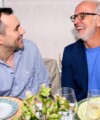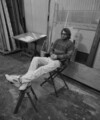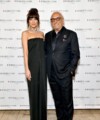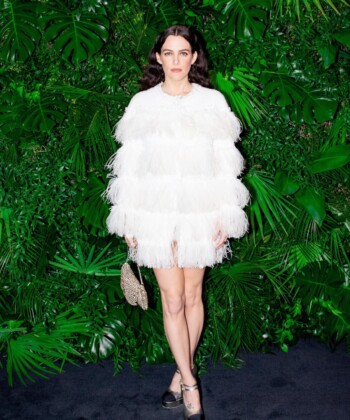“I got Salinger.”
It’s what Newsweek photographer Michael McDermott told the newsroom after capturing J.D. Salinger on a two-day stakeout at the famously reclusive author’s mailbox in the ’70s. And it’s what director Shane Salerno is telling Hollywood now. On September 6th, his bio-documentary Salinger hits theaters in tandem with a book by the same name. The ten-year passion project pulls back the curtain on the American author, revealing reams of tabloid-worthy gossip and new information about a few posthumous works in the pipeline. Neither a biographer nor a journalist, Salerno is first—and forever—a fan. “There’s wonderful stories about him, and there’s some tough stories about him, but all along the film honors him and honors his work and his extraordinary contribution to literature.”
Salerno took a moment to speak to DuJour about his first memory of reading Catcher in the Rye and why a decade spent on the project still wasn’t enough.
 Shane Salerno. Photo: Getty
Shane Salerno. Photo: Getty
You’re a lifelong Salinger fan. Where did your fascination begin?
When I was a kid, Salinger was a big deal in my house. My mom would talk about him all the time and was such a fan of his work. And she would always talk about this great mythic figure who turned his back on celebrity and retreated to the woods of New Hampshire, so my love of his work [came from] there. But I knew very little about his life, so I spent ten years of my life making this film and working on the book.
After a decade spent on this project, when did you know that it was complete, that you were finally done?
When Harvey Weinstein said we’re opening September 6th. [Laughs]. I thought it would have gone on for another couple of years if it wasn’t for a release date. But I really did know after Jean Miller’s interview [Miller was a former lover of Salinger who met him at age 14]. It’s the first time she’s ever spoken in 60 years—that was a major breakthrough for us. And the second thing was the Fitzgerald family, who, after 60 years of not showing any of the photos, letters or diaries, allowed us to have those materials.
This is not like making a documentary about Lance Armstrong or Ted Kennedy where there’s all kinds of footage. Every photo was like an archeological dig, and it’s incredibly exciting whenever we found a new one.
 A WWII photo of Salinger (left) from Paul Fitzgerald
A WWII photo of Salinger (left) from Paul Fitzgerald
Any personal favorite findings?
Jean Miller had a photo of him—it’s one of the few photos I saw of him where he’s truly happy and truly at peace. We’re so used to these dark photos of J.D. Salinger and there really was another side to him, and that was Jerry. No one who knew and loved him called him J.D.—they called him Jerry—and had very happy times with him. We wanted to make sure we represented that in the film and the book.
What are you doing now with all this material you’ve amassed?
It’s a really interesting question… We’ve probably gathered the largest collection of Salinger letters anywhere in the world. Several hundred. We have certainly gathered military records which have never been seen before—some you see in the book and in the film—but it’s a good question. We’ll have to figure it out when the time comes.
How did you gain the trust of Salinger’s friends and family, even the biographers you spoke with like A. Scott Berg? For years you didn’t have it.
The first few years was a process of being rejected all the time. It was a bit like that scene in All the Presidents’ Men where they go door-to-door and people kept slamming the door—the phone in our case. People have protected some of these stories for 50 or 60 years, so you can imagine convincing them to speak was extraordinarily difficult. I think over time we earned people’s trust, over time people saw how committed we were.
I’m sure his death in 2010 played a major role as well.
Certainly Mr. Salinger’s passing opened up doors that were not ever going to be opened prior to that event. Jean Miller had made a personal promise to herself that she was never going to tell her story while he was alive. [His passing] provided the opportunity for people to share their stories without feeling like they were betraying him. That was the major moment.
Your film reports that five unpublished works by Salinger will be released starting in 2015. Do you have anything special planned when the first posthumous work is published?
Well I certainly want to be the first one to read them! I’m incredibly excited, and I think the world is. I looked last night on Amazon to find out where Catcher in the Rye was [ranking] and incredibly it’s the number-seven book in the world on Amazon. So a book that goes from 1951 to once again in the top ten is a testament to the work and people’s continued interest in Salinger.
What’s your first memory of reading Catcher?
My first memory is reading and thinking, “Oh my God.” You know, it was the only time I ever felt that literally my thoughts have been translated onto paper, and I thought that the author has written this book specifically for me. And it’s funny, whether it’s Ed Norton or Philip Seymour Hoffman or Scott Berg or any of the people we talked to, that’s the reaction they had. And what’s amazing is that’s the reaction readers still have in 2013 for a book that was written in 1951. It’s an astonishing testament to Salinger’s staying power, which is the mark of a true artist.
MORE:
The Astor Who Lost It All
10 Anecdotes of Excess About the Johnson & Johnson Family
Did the Emanuel Brothers’ Success Come at Their Mother’s Expense?










































